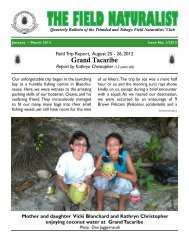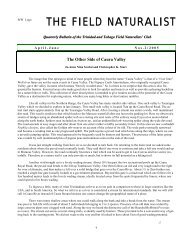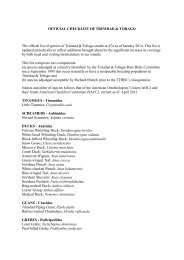A Survey of Freshwater Macroinvertebrates in Tobago - The Trinidad ...
A Survey of Freshwater Macroinvertebrates in Tobago - The Trinidad ...
A Survey of Freshwater Macroinvertebrates in Tobago - The Trinidad ...
Create successful ePaper yourself
Turn your PDF publications into a flip-book with our unique Google optimized e-Paper software.
Bivalvia<br />
Only a s<strong>in</strong>gle species <strong>of</strong> freshwater clam was collected. <strong>The</strong><br />
f<strong>in</strong>gernail clam, Eupera cubensis, was found <strong>in</strong> the sediments <strong>of</strong><br />
Buccoo Marsh where it filters and feeds on bacteria suspended <strong>in</strong><br />
the water. This clam has a widespread distribution throughout the<br />
Holarctic, <strong>in</strong>clud<strong>in</strong>g islands <strong>of</strong> the Lesser Antilles, such as Nevis<br />
(Bass 2000).<br />
Amphipoda<br />
Grandidierella was collected from submerged detritus along<br />
the edge <strong>of</strong> the Bacolet River. Amphipods are usually detritivores<br />
and scavengers.<br />
Decapoda<br />
Decapods are one <strong>of</strong> the best known groups <strong>of</strong> freshwater<br />
<strong>in</strong>vertebrates <strong>in</strong> <strong>Tobago</strong> (Chace and Hobbs 1969; Hart 1980). A<br />
total <strong>of</strong> 11 freshwater decapods have been reported from the island.<br />
<strong>The</strong>se <strong>in</strong>clude 10 species <strong>of</strong> shrimp and one species <strong>of</strong> crab. Here,<br />
the shrimp, Potimirim, is reported for the first time from <strong>Tobago</strong>.<br />
<strong>The</strong> Atya sp. and Macrobrachium sp. listed <strong>in</strong> Table 1 probably<br />
belong to species that were previously reported. Whereas both Atya<br />
and Macrobrachium are omnivorous as juveniles, Atya develops<br />
<strong>in</strong>to a collector and Macrobrachium becomes more predacious as<br />
it matures (A. Covich, pers. com.). All shrimps were usually found<br />
<strong>in</strong> streams among submerged detritus and plant roots.<br />
Ephemeroptera<br />
At least seven species <strong>of</strong> mayflies are known from <strong>Tobago</strong>.<br />
This number may be higher s<strong>in</strong>ce some genera listed may conta<strong>in</strong><br />
more than one species. Accurate species determ<strong>in</strong>ations <strong>of</strong> mayflies<br />
<strong>of</strong>ten require the adult stage and the collections conta<strong>in</strong>ed only the<br />
aquatic nymphs. Farrodes grenadensis was previously reported<br />
from nearby Grenada by Edmunds et al. (1976). However, based<br />
on differences <strong>in</strong> color and maculation <strong>of</strong> the abdomen, another<br />
species, Farrodes sp. 1, was determ<strong>in</strong>ed to be present <strong>in</strong> this<br />
collection (M. Pescador, pers. com.). Leptohyphes zapode was<br />
recently found <strong>in</strong> <strong>Tobago</strong> (Baumgardner, D.E., Burian, S.K. and<br />
Bass, D., unpublished observations). It is possible some <strong>of</strong> the<br />
specimen designated Leptohyphes sp. 1 collected <strong>in</strong> this<br />
<strong>in</strong>vestigation may actually be Leptohyphes zapode, but the def<strong>in</strong>itive<br />
characteristics had not yet developed <strong>in</strong> the specimen.<br />
Odonata<br />
Five species <strong>of</strong> odonates have been collected <strong>in</strong> <strong>Tobago</strong>. Of<br />
these, three are dragonflies and two are damselflies. <strong>The</strong> most<br />
common taxa observed <strong>in</strong>clude Argia sp. and Ischnura ramburii.<br />
All are predators and nymphs live among submerged leaf debris.<br />
S<strong>in</strong>ce the adults are strong fliers, odonates have a fairly widespread<br />
distribution <strong>in</strong> the West Indies, with only a few species be<strong>in</strong>g<br />
endemic to a s<strong>in</strong>gle island (Fl<strong>in</strong>t 1978). No endemic species <strong>of</strong> this<br />
group are known to exist on <strong>Tobago</strong>.<br />
Plecoptera<br />
Stark (1994) described a new species <strong>of</strong> stonefly, Anacroneuria<br />
isleta, from forested areas <strong>of</strong> eastern <strong>Tobago</strong>. This is the only known<br />
species <strong>of</strong> stonefly on the island and it appears to be endemic to<br />
<strong>Tobago</strong>. <strong>The</strong> immature stage, presumably aquatic, is unknown and<br />
I did not encounter this species <strong>in</strong> my collections.<br />
Hemiptera<br />
Hemipterans were a common group encountered dur<strong>in</strong>g this<br />
<strong>in</strong>vestigation, be<strong>in</strong>g collected from most sites. Of the 20 species<br />
listed <strong>in</strong> Table 1, 19 were already known to occur on <strong>Tobago</strong> (Nieser<br />
and Alk<strong>in</strong>s-Koo 1991). Most water bugs collected <strong>in</strong> the present<br />
<strong>Macro<strong>in</strong>vertebrates</strong> <strong>in</strong> <strong>Tobago</strong><br />
Copyright TTFNC<br />
67<br />
study were various species <strong>of</strong> water striders, with Brachymetra<br />
alb<strong>in</strong>ervis, Mesovelia mulsanti, and Rhagovelia isularis be<strong>in</strong>g the<br />
most common taxa found. All are predators <strong>of</strong> smaller <strong>in</strong>sects. <strong>The</strong><br />
phenomena <strong>of</strong> w<strong>in</strong>g polymorphism and flightlessness were<br />
observed <strong>in</strong> several populations. <strong>The</strong> loss <strong>of</strong> w<strong>in</strong>gs is a widespread<br />
phenomenon that has been well documented <strong>in</strong> water striders<br />
(Schuh and Shlater 1995; Thorp and Covich 2001) and among island<br />
populations (Darw<strong>in</strong> 1859). This loss <strong>of</strong> w<strong>in</strong>gs is beneficial s<strong>in</strong>ce<br />
the energy cost to ma<strong>in</strong>ta<strong>in</strong> them may be high (R<strong>of</strong>f 1986) and<br />
they may be <strong>of</strong> little value on a small island (Darw<strong>in</strong> 1859),<br />
especially if the aquatic habitats are persistent so flight is not<br />
necessary (R<strong>of</strong>f 1990). Although w<strong>in</strong>gs may be a useful mechanism<br />
as a means for dispersal, they may also be considered deleterious<br />
if an <strong>in</strong>sect flies away from an island because its chance for survival<br />
is greatly reduced once it journeys over the sea (Darw<strong>in</strong> 1859).<br />
However, it is unlikely fly<strong>in</strong>g <strong>in</strong>sects would leave an island <strong>in</strong> large<br />
numbers (R<strong>of</strong>f 1990).<br />
Trichoptera<br />
Four species <strong>of</strong> immature trichopterans were collected from<br />
freshwater environments <strong>in</strong> <strong>Tobago</strong> dur<strong>in</strong>g this study. However,<br />
only one <strong>of</strong> these, Leptonema albovirens, was common. Most<br />
caddisfly larvae were found among submerged leaf debris and<br />
rocks. In previous studies, Botosaneanu and Alk<strong>in</strong>s-Koo (1993)<br />
reported at least 19 species <strong>of</strong> caddisflies were collected from six<br />
sites <strong>in</strong> <strong>Tobago</strong>. Fl<strong>in</strong>t (1996) listed 33 species <strong>of</strong> caddisflies from<br />
<strong>Tobago</strong>, <strong>of</strong> which seven are endemic to <strong>Tobago</strong> while another six<br />
are limited to only <strong>Tobago</strong> and Tr<strong>in</strong>idad. As additional collections<br />
are made on nearby islands and the South American ma<strong>in</strong>land, it is<br />
suspected some <strong>of</strong> the species currently thought to be endemic<br />
may be discovered to have greater ranges than are currently known.<br />
Lepidoptera<br />
Petrophila was the only aquatic lepidopteran found on <strong>Tobago</strong>.<br />
Larvae were collected from their small, self-spun silken retreats<br />
cover<strong>in</strong>g the <strong>in</strong>dentations <strong>of</strong> rocks <strong>in</strong> shallow stream environments.<br />
<strong>The</strong>se larvae scrape algae and other organic material from the<br />
surface <strong>of</strong> submerged rocks, probably dur<strong>in</strong>g hours <strong>of</strong> darkness.<br />
Coleoptera<br />
H<strong>in</strong>ton (1971) reported six species <strong>of</strong> elmids (riffle beetles)<br />
exist<strong>in</strong>g <strong>in</strong> <strong>Tobago</strong>. Although 13 species <strong>of</strong> freshwater beetles are<br />
known from <strong>Tobago</strong> today, none appear to be common or occur <strong>in</strong><br />
large numbers. It is <strong>in</strong>terest<strong>in</strong>g to note that no more than one species<br />
was collected from any site.<br />
Diptera<br />
Seven species <strong>of</strong> dipteran larvae were encountered dur<strong>in</strong>g this<br />
<strong>in</strong>vestigation, <strong>in</strong>clud<strong>in</strong>g five midges. Because midge larvae are <strong>of</strong>ten<br />
very small and primarily <strong>in</strong>habit the sediments, a more extensive<br />
sampl<strong>in</strong>g effort <strong>of</strong> the sediments would probably yield additional<br />
species.<br />
Species richness varied between the sites sampled. Sites hav<strong>in</strong>g<br />
greatest diversities generally were those <strong>of</strong> streams hav<strong>in</strong>g cobble<br />
substrates and flow<strong>in</strong>g through forested land where human impact<br />
appeared m<strong>in</strong>imal. Species richness was greatest at a site <strong>in</strong> the<br />
Argyle River near Argyle Falls and lowest <strong>in</strong> an isolated pool <strong>of</strong> a<br />
non-flow<strong>in</strong>g section <strong>of</strong> K<strong>in</strong>g’s Bay River.<br />
Hynes (1971) concluded the zonation <strong>of</strong> stream<br />
macro<strong>in</strong>vertebrates <strong>in</strong> the Arima River system <strong>of</strong> Tr<strong>in</strong>idad was based<br />
largely on elevational differences. For this study <strong>of</strong> <strong>Tobago</strong><br />
macro<strong>in</strong>vertebrates, it is difficult to conclude which, if any, <strong>of</strong> the








